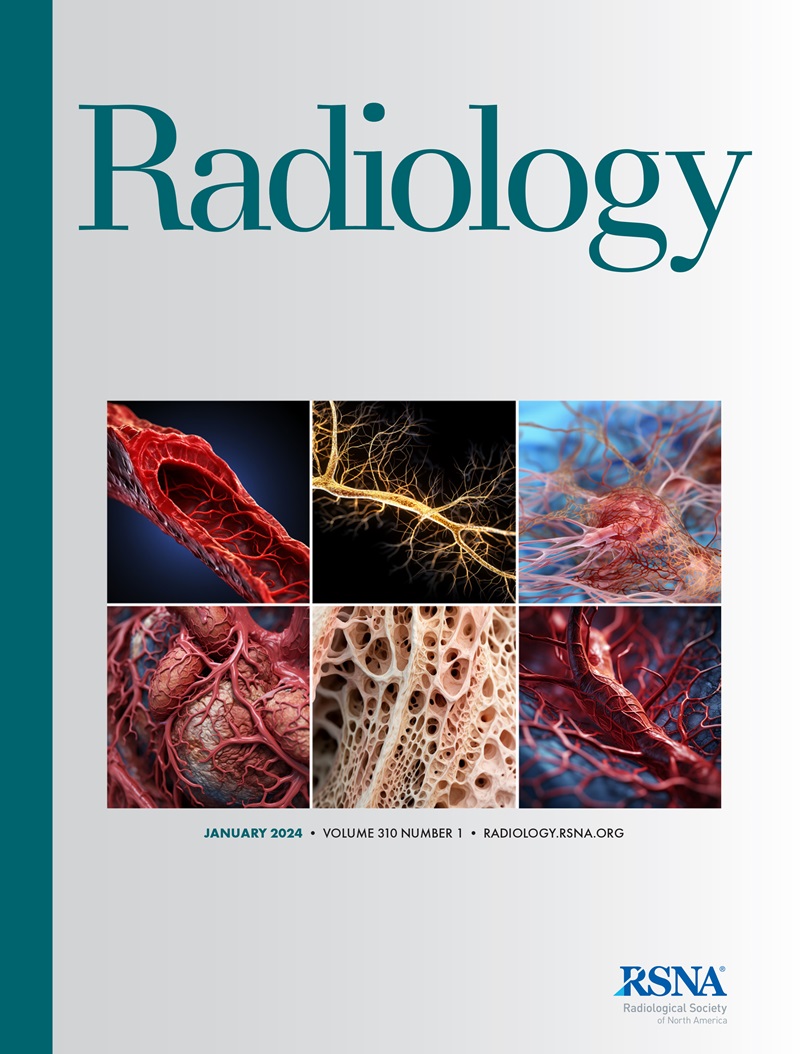Yao-Jun Zhang, Jinbin Chen, Zhongguo Zhou, Dandan Hu, Juncheng Wang, Yangxun Pan, Yizhen Fu, Zili Hu, Li Xu, Min-Shan Chen
求助PDF
{"title":"经动脉化疗栓塞射频消融与手术切除治疗小的晚期复发肝细胞癌。","authors":"Yao-Jun Zhang, Jinbin Chen, Zhongguo Zhou, Dandan Hu, Juncheng Wang, Yangxun Pan, Yizhen Fu, Zili Hu, Li Xu, Min-Shan Chen","doi":"10.1148/radiol.241096","DOIUrl":null,"url":null,"abstract":"<p><p>Background Radiofrequency ablation (RFA) has comparable clinical outcomes to surgical resection (SR) for treating small recurrent hepatocellular carcinoma (HCC). However, whether combined transarterial chemoembolization (TACE) with RFA (hereafter, TACE-RFA) outperforms SR for treating small late-recurrence HCCs remains unknown. Purpose To compare the clinical outcome of TACE-RFA with that of SR in patients with small late-recurrence HCCs. Materials and Methods This randomized clinical trial recruited patients between July 2013 and March 2019. Patients with small late-recurrence HCCs (a single recurrent HCC nodule [≤ 5 cm in diameter] or three or fewer nodules [each ≤ 3 cm in diameter] and recurrence at least 12 months after radical therapy of primary HCC) were randomly assigned to receive TACE-RFA or SR. The primary end point was overall survival (OS). The secondary end points included recurrence-free survival (RFS) and the incidence of complications. OS and RFS were assessed using the Kaplan-Meier method and log-rank test. Results In the intention-to-treat analysis, 210 patients (mean age, 52 years ± 12 [SD]; 194 male) were included, with 105 patients in each group. The 1-, 3-, and 5-year OS rates were 99%, 81%, and 69%, respectively, in the TACE-RFA group and 96%, 81%, and 76%, respectively, in the SR group (hazard ratio [HR], 1.34; 95% CI: 0.81, 2.23; <i>P</i> = .26). The 1-, 3-, and 5-year RFS rates were 71%, 38%, and 24%, respectively, in the TACE-RFA group and 73%, 43%, and 29%, respectively, in the SR group (HR, 1.05; 95% CI: 0.76, 1.45; <i>P</i> = .78). The incidence of complications was greater in the SR group than in the TACE-RFA group (41% [43 of 104] vs 24% [23 of 96]; <i>P</i> = .01). Conclusion For patients with small late-recurrence HCCs, TACE-RFA did not yield better survival outcomes than SR. However, the incidence of complications was lower in patients who received TACE-RFA therapy. ClinicalTrials.gov Identifier: NCT01833286 © RSNA, 2025 <i>Supplemental material is available for this article.</i> See also the editorial by Ronot in this issue.</p>","PeriodicalId":20896,"journal":{"name":"Radiology","volume":"314 2","pages":"e241096"},"PeriodicalIF":12.1000,"publicationDate":"2025-02-01","publicationTypes":"Journal Article","fieldsOfStudy":null,"isOpenAccess":false,"openAccessPdf":"","citationCount":"0","resultStr":"{\"title\":\"Transarterial Chemoembolization with Radiofrequency Ablation versus Surgical Resection for Small Late-Recurrence Hepatocellular Carcinoma.\",\"authors\":\"Yao-Jun Zhang, Jinbin Chen, Zhongguo Zhou, Dandan Hu, Juncheng Wang, Yangxun Pan, Yizhen Fu, Zili Hu, Li Xu, Min-Shan Chen\",\"doi\":\"10.1148/radiol.241096\",\"DOIUrl\":null,\"url\":null,\"abstract\":\"<p><p>Background Radiofrequency ablation (RFA) has comparable clinical outcomes to surgical resection (SR) for treating small recurrent hepatocellular carcinoma (HCC). However, whether combined transarterial chemoembolization (TACE) with RFA (hereafter, TACE-RFA) outperforms SR for treating small late-recurrence HCCs remains unknown. Purpose To compare the clinical outcome of TACE-RFA with that of SR in patients with small late-recurrence HCCs. Materials and Methods This randomized clinical trial recruited patients between July 2013 and March 2019. Patients with small late-recurrence HCCs (a single recurrent HCC nodule [≤ 5 cm in diameter] or three or fewer nodules [each ≤ 3 cm in diameter] and recurrence at least 12 months after radical therapy of primary HCC) were randomly assigned to receive TACE-RFA or SR. The primary end point was overall survival (OS). The secondary end points included recurrence-free survival (RFS) and the incidence of complications. OS and RFS were assessed using the Kaplan-Meier method and log-rank test. Results In the intention-to-treat analysis, 210 patients (mean age, 52 years ± 12 [SD]; 194 male) were included, with 105 patients in each group. The 1-, 3-, and 5-year OS rates were 99%, 81%, and 69%, respectively, in the TACE-RFA group and 96%, 81%, and 76%, respectively, in the SR group (hazard ratio [HR], 1.34; 95% CI: 0.81, 2.23; <i>P</i> = .26). The 1-, 3-, and 5-year RFS rates were 71%, 38%, and 24%, respectively, in the TACE-RFA group and 73%, 43%, and 29%, respectively, in the SR group (HR, 1.05; 95% CI: 0.76, 1.45; <i>P</i> = .78). The incidence of complications was greater in the SR group than in the TACE-RFA group (41% [43 of 104] vs 24% [23 of 96]; <i>P</i> = .01). Conclusion For patients with small late-recurrence HCCs, TACE-RFA did not yield better survival outcomes than SR. However, the incidence of complications was lower in patients who received TACE-RFA therapy. ClinicalTrials.gov Identifier: NCT01833286 © RSNA, 2025 <i>Supplemental material is available for this article.</i> See also the editorial by Ronot in this issue.</p>\",\"PeriodicalId\":20896,\"journal\":{\"name\":\"Radiology\",\"volume\":\"314 2\",\"pages\":\"e241096\"},\"PeriodicalIF\":12.1000,\"publicationDate\":\"2025-02-01\",\"publicationTypes\":\"Journal Article\",\"fieldsOfStudy\":null,\"isOpenAccess\":false,\"openAccessPdf\":\"\",\"citationCount\":\"0\",\"resultStr\":null,\"platform\":\"Semanticscholar\",\"paperid\":null,\"PeriodicalName\":\"Radiology\",\"FirstCategoryId\":\"3\",\"ListUrlMain\":\"https://doi.org/10.1148/radiol.241096\",\"RegionNum\":1,\"RegionCategory\":\"医学\",\"ArticlePicture\":[],\"TitleCN\":null,\"AbstractTextCN\":null,\"PMCID\":null,\"EPubDate\":\"\",\"PubModel\":\"\",\"JCR\":\"Q1\",\"JCRName\":\"RADIOLOGY, NUCLEAR MEDICINE & MEDICAL IMAGING\",\"Score\":null,\"Total\":0}","platform":"Semanticscholar","paperid":null,"PeriodicalName":"Radiology","FirstCategoryId":"3","ListUrlMain":"https://doi.org/10.1148/radiol.241096","RegionNum":1,"RegionCategory":"医学","ArticlePicture":[],"TitleCN":null,"AbstractTextCN":null,"PMCID":null,"EPubDate":"","PubModel":"","JCR":"Q1","JCRName":"RADIOLOGY, NUCLEAR MEDICINE & MEDICAL IMAGING","Score":null,"Total":0}
引用次数: 0
引用
批量引用

 求助内容:
求助内容: 应助结果提醒方式:
应助结果提醒方式:


